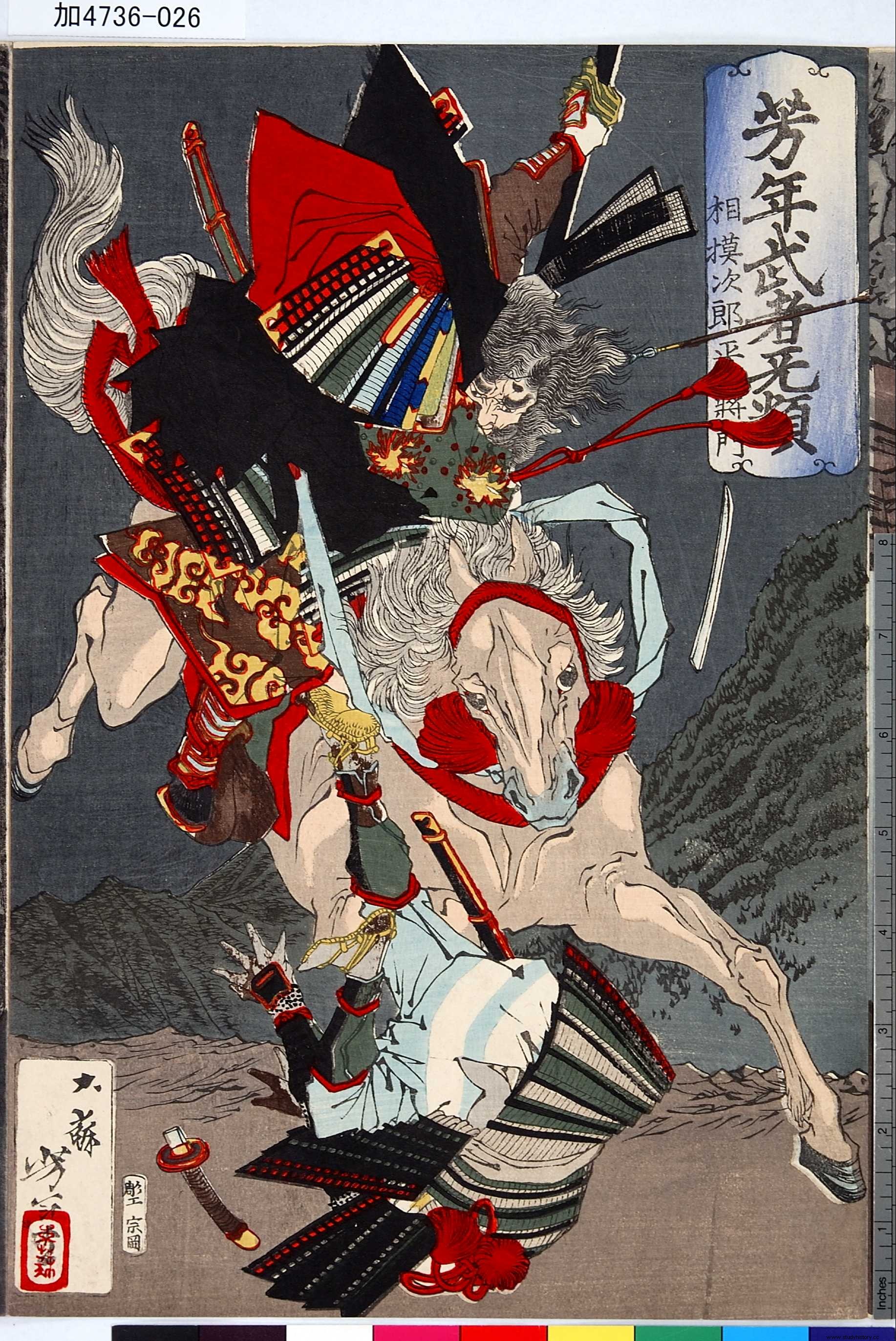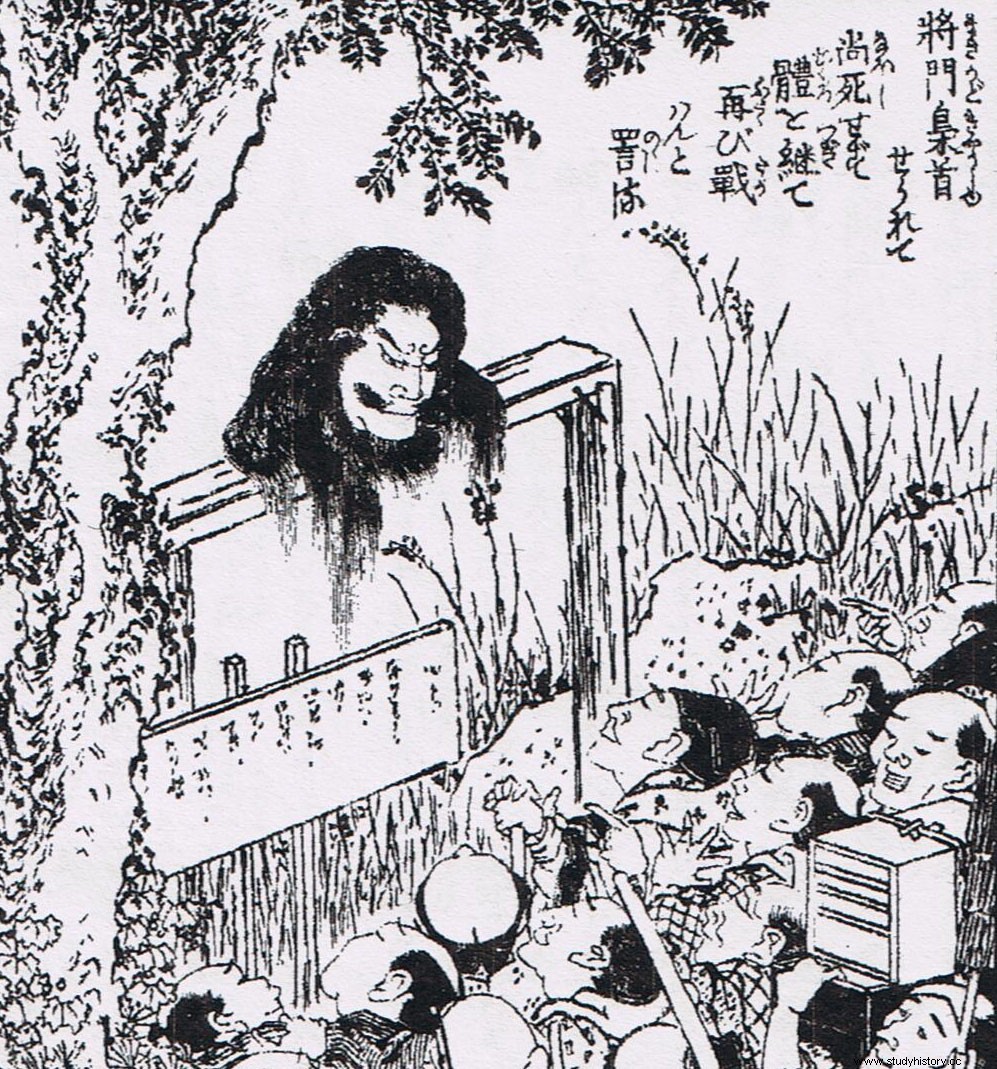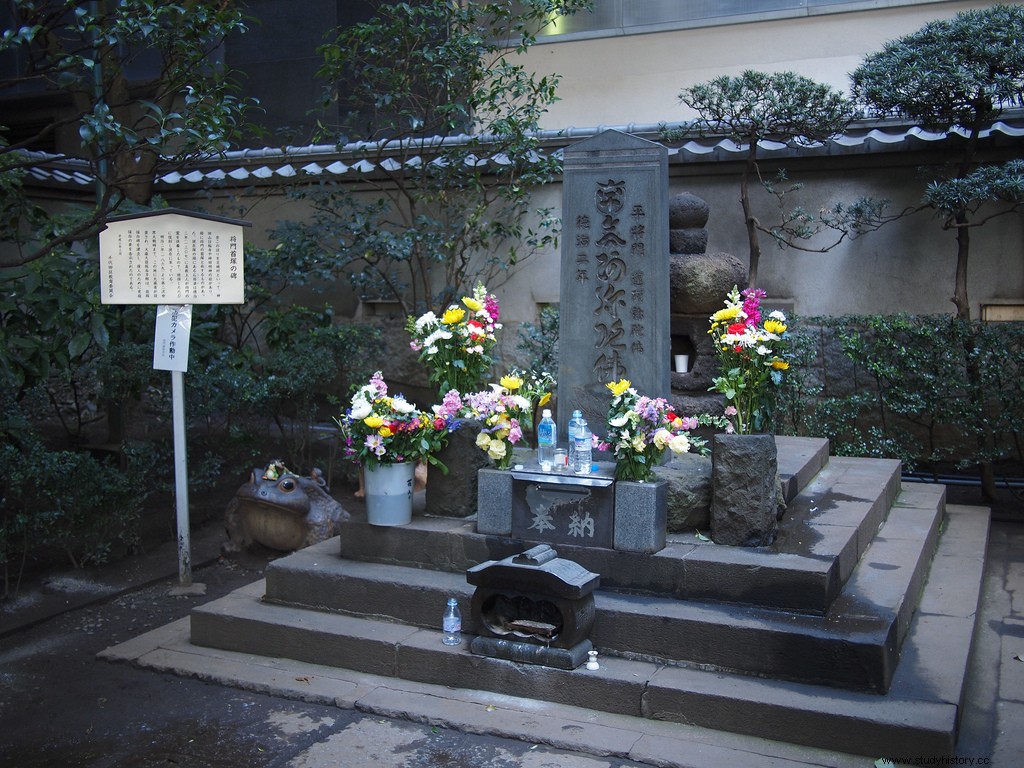In the heart of Tokyo, surrounded by neon lights and concrete masses, there is a small tomb where the remains of an ancient samurai leader have rested since ancient times. This is Taira No Masakado , one of the great villains in the history of Japan. Actually, only his head is buried there, which was separated from his neck as punishment for his crimes. And it is also said that around that place, in the middle of the Otemachi district, , the Japanese Wall Street, where the buildings of large corporations grow like mushrooms, strange events and deaths occur in mysterious circumstances. No, we have not made the wrong blog, this is still Stories of History. But, in the case of Japan, history and legend almost always go hand in hand. We are going to try to separate reality and fiction and tell how the supposed cursed head of this Sleepy Hollow samurai ended up there. , and if he really was as evil as he is painted.

Masakado Tomb Indication
At the end of the 10th century, Japan was in the midst of the Heian era. , a time of flourishing of arts and culture. The country is theoretically under the direct authority of the emperor, who orders and commands from his palace in the resplendent new capital, Kyoto. But the son of heaven and his courtiers were more interested in poetry than government tasks, and those who really pulled the strings of national politics were a few noble families who did and undid as they pleased. At the same time, in the territories farthest from the capital, a thriving provincial nobility began to prosper, eminently warriors, who, despite being theoretically at the service of the court, went rather on their own, without worrying too much about the regent on duty. They were the first samurai .
In those days, a samurai was basically a somewhat rustic type who earned his rice by fighting barbarian tribes for lost provinces at the hand of Buddha, almost always to defend the interests and lands of the decadent court nobility who, many kilometers away away, in Kyoto, he dedicated himself to sipping sake and composing verses in the moonlight. The young Taira No Masakado he was one of these provincial warriors, raised on the plains of Kanto, not far from present-day Tokyo. But, like all members of the Taira clan that worth his salt, the time has come to go to the capital to make a career. The Taira they were one of the oldest and most prestigious samurai lineages. Related to the imperial family itself, they have played a key role in the history of Japan since the dawn of time.
But the niceties of the court turned out to be more complex than Masakado expected. Making his way through that train of sybarites and grateful stomachs was not an easy task for a tough soldier from the provinces like him. Thus, Masakado's brief career in the palace came to a screeching halt when he unsuccessfully tried to apply for the position of kebiishi , a kind of police commissioner of the time. The position ended up in the hands of the plugged in shift and the thing could have stayed there, but Masakado, who had a very bad start, took the failure tremendously. He stormed back to his homeland and began plotting a rebellion to show those scheming courtiers how the Kanto samurai got along.
And boy would they know. The Masakado revolt was going to be one of those that make history, it was not long before the entire empire collapsed. Some sources even attribute to him having named himself emperor, forming in Kanto an alternative court to that of Kyoto where he distributed titles and lands as if he were the true son of heaven. While it is doubtful that he would go that far, there was no one in all of Japan who could cough at him. His victories on the battlefield followed one after another, and he managed to massacre with insulting ease any army sent against him. The Kyoto nobles, led by the emperor, were completely distraught.

Masakado fighting
Masakado's true motives are unclear. It is difficult to recreate the exact course of events, but the most credible sources speak of a Masakado who returns to his lands with his tail between his legs after the spite suffered in Kyoto, only to find himself involved in an unfortunate chain of family disputes, with the Minamoto clan , secular enemy of the Taira , also put in the garlic. What started as a simple skirmish between local chieftains ended up getting out of hand to the point that Masakado found himself, suddenly, confronted with the imperial government and his own family. He probably had no choice but to throw himself into the bush and declare himself in rebellion. Masakado's rebellion was nothing more than a flight forward. By instigating uprisings and pickling any punitive expedition they threw at him, he hoped to stifle the emperor and his ministers to such an extent that they had no choice but to agree to negotiate an honorable way out. The problem was that Masakado was far better at crushing enemies than he was at maneuvering high politics. Far from getting loose, with each passing day his mess grew fatter and fatter.
After five years of battles, in which each of the warlords in contention was declared a rebel and enemy of the state as soon as he was named imperial paladin to annihilate the opposing faction, on the 14th day of the Second Month of 940, Masakado was finally defeated. His revolutionary crusade was to culminate in his head being exposed on top of a pike in the middle of Kyoto.

Or maybe not, because, according to legend, Masakado's head still had adventures to live once separated from his body. Instead of being eaten by the worms, the chronicles relate that, shortly after being in the pillory, a terrible grimace began to appear on Masakado's severed head. His teeth gnashed at her like filthy knives on a grinder's grindstone, and his eyes, flashing with fury like red-hot coals, bulged out of their sockets. It seemed that he had come to life again. Finally hurling curses and crying vengeance against the world, his head began to levitate and he took off with a fresh wind. Floating, floating, never stopping spitting curses wherever he went, he ended up in his native Kanto, in the middle of what is now the very center of the Tokyo metropolis. And there, ten centuries later, he continues to rest.

Masakado's Tomb
But Masakado's spirit seems to be a difficult guest to deal with, prone to causing plagues, earthquakes, and natural disasters of all kinds whenever the locals forget to show him the proper respect. A thousand years after his death, the fearsome warrior Taira continues to display the same rebellious character that he had in life. Simple urban legends? Surely yes. But, even today, the people of Tokyo take great care to keep Masakado's grave well cared for… just in case.
Collaboration of R. Ibarzabal
Sources:"The First Samurai:The Life and Legend of the Warrior Rebel » – Taira Masakado
